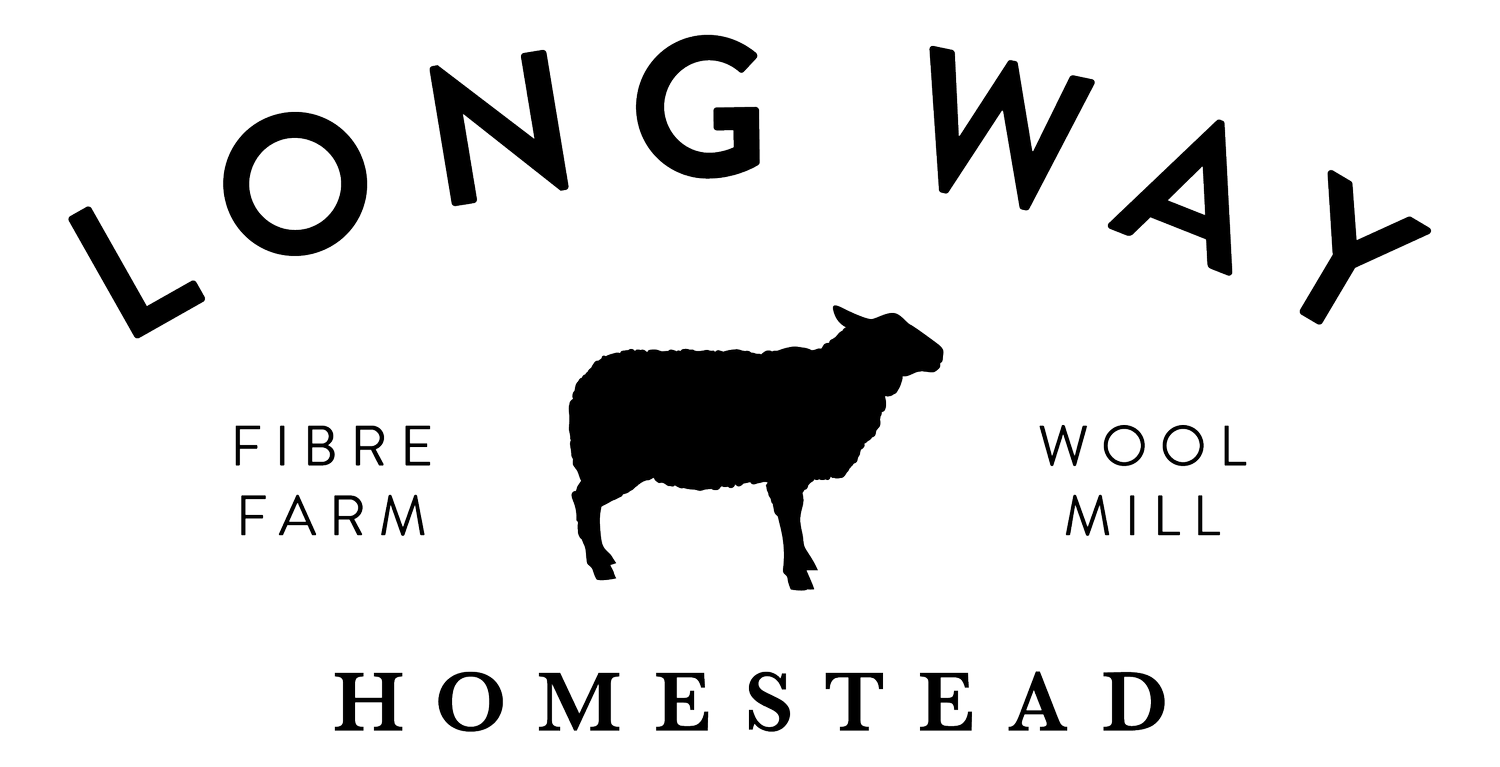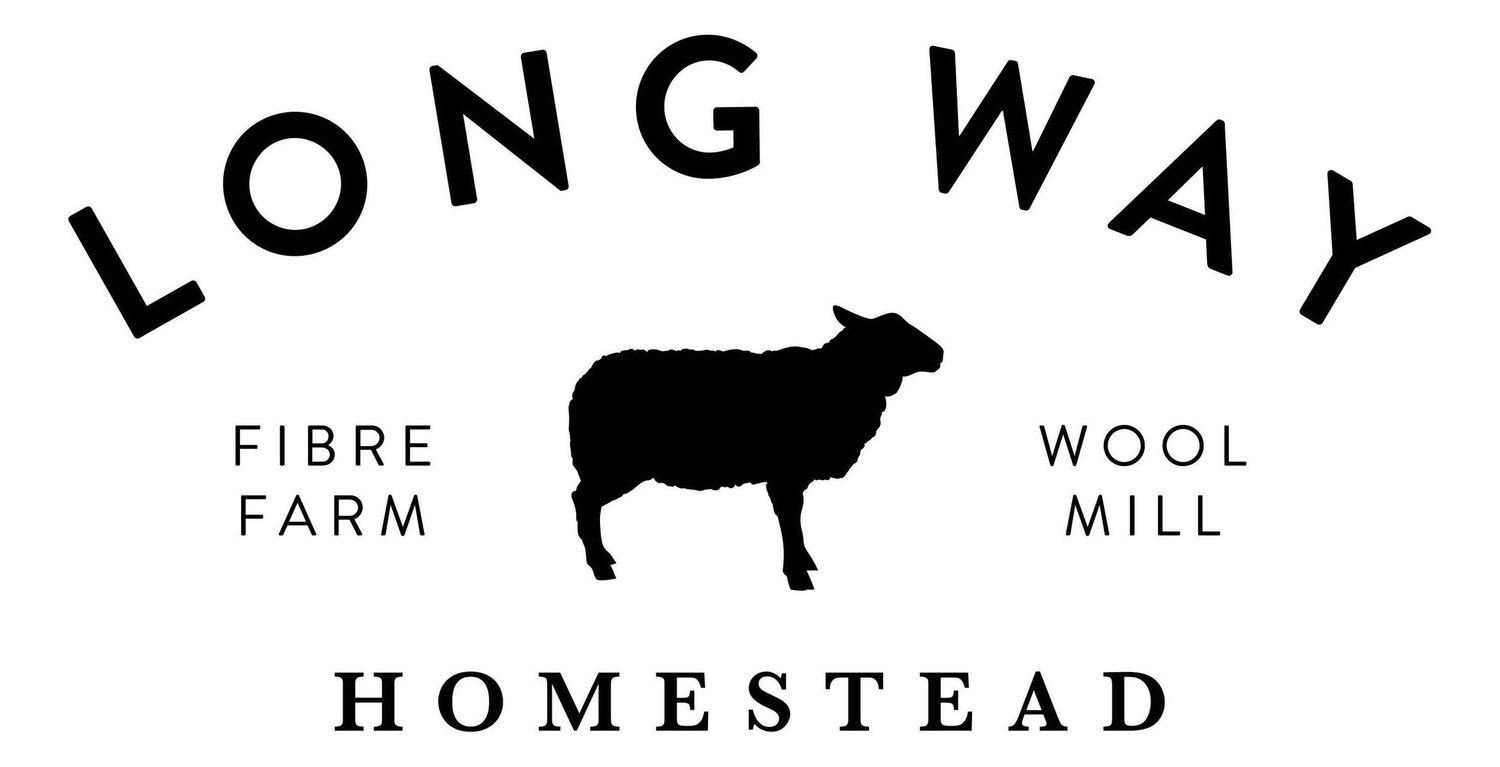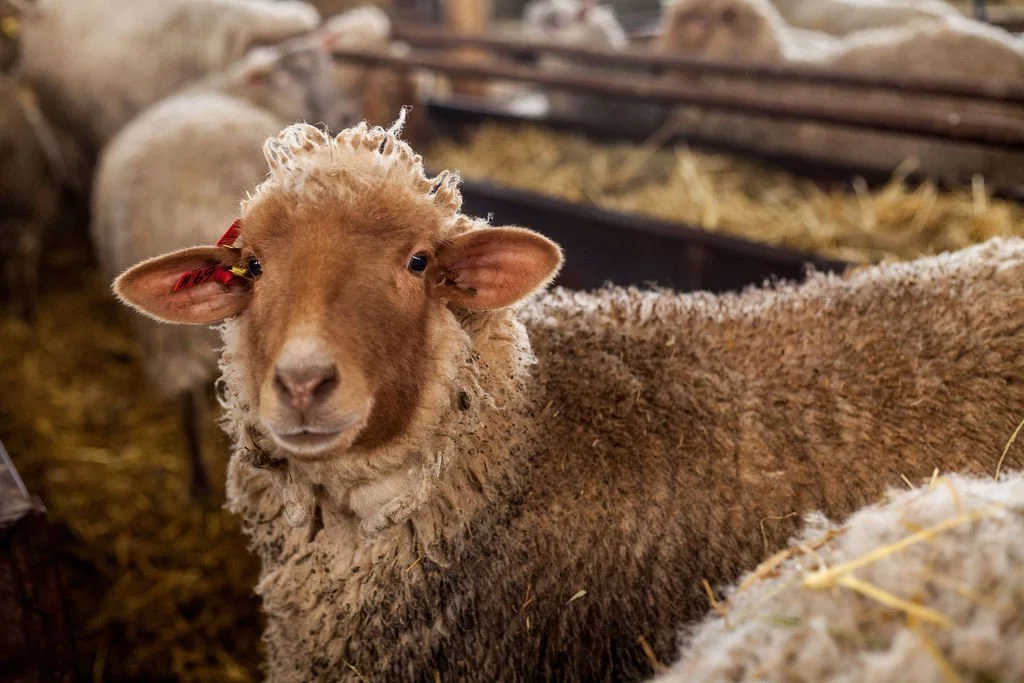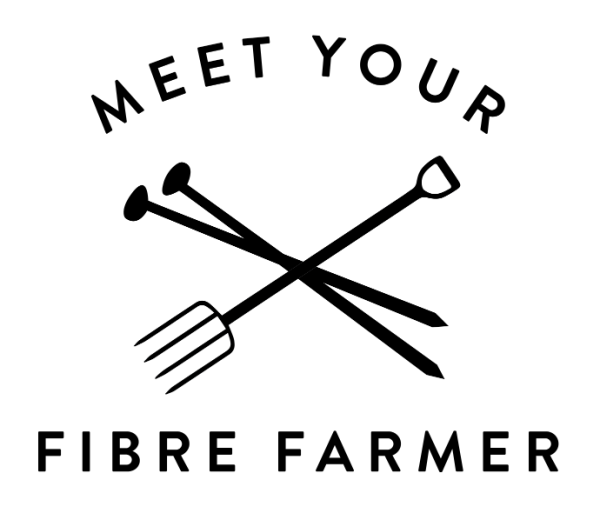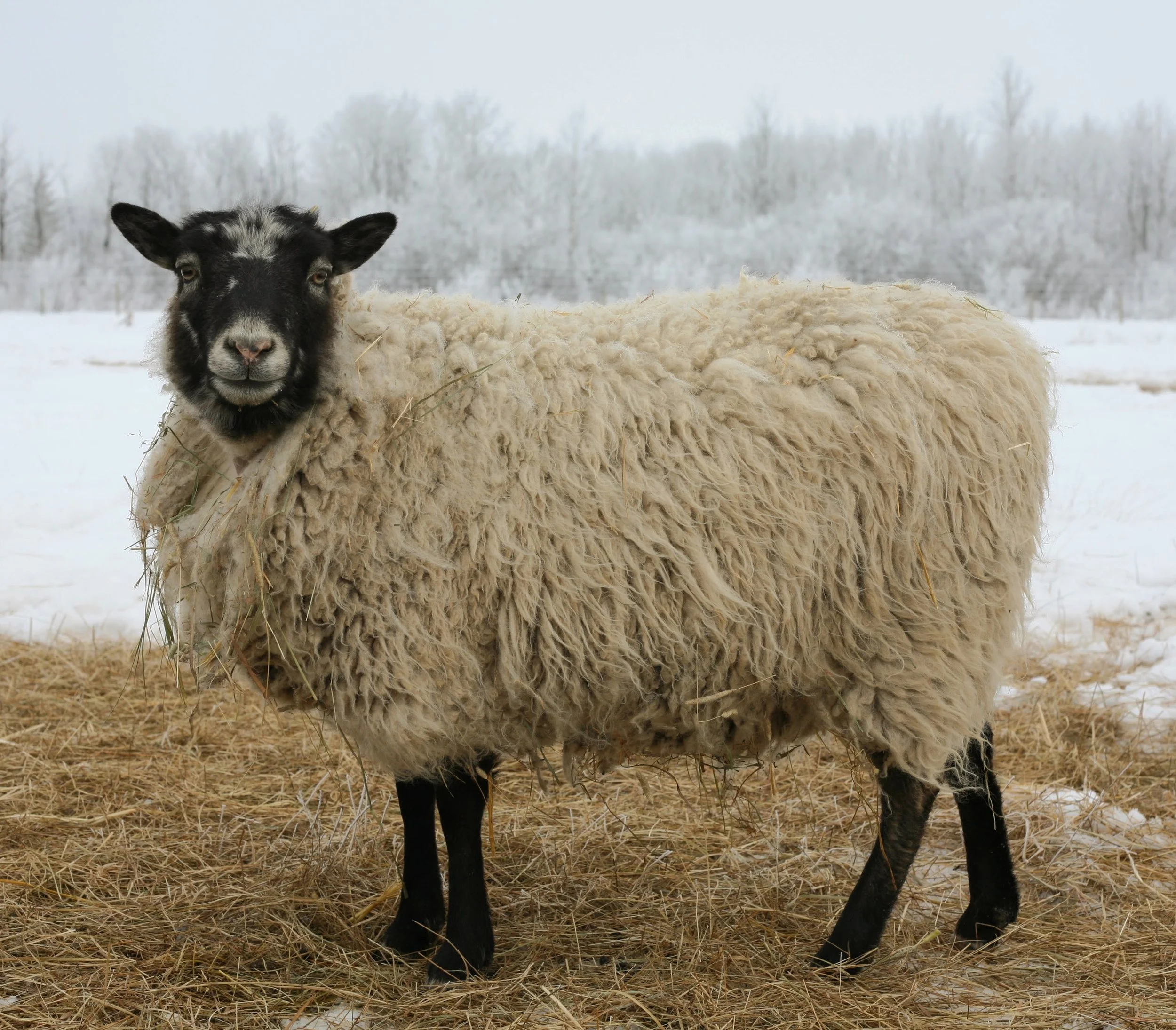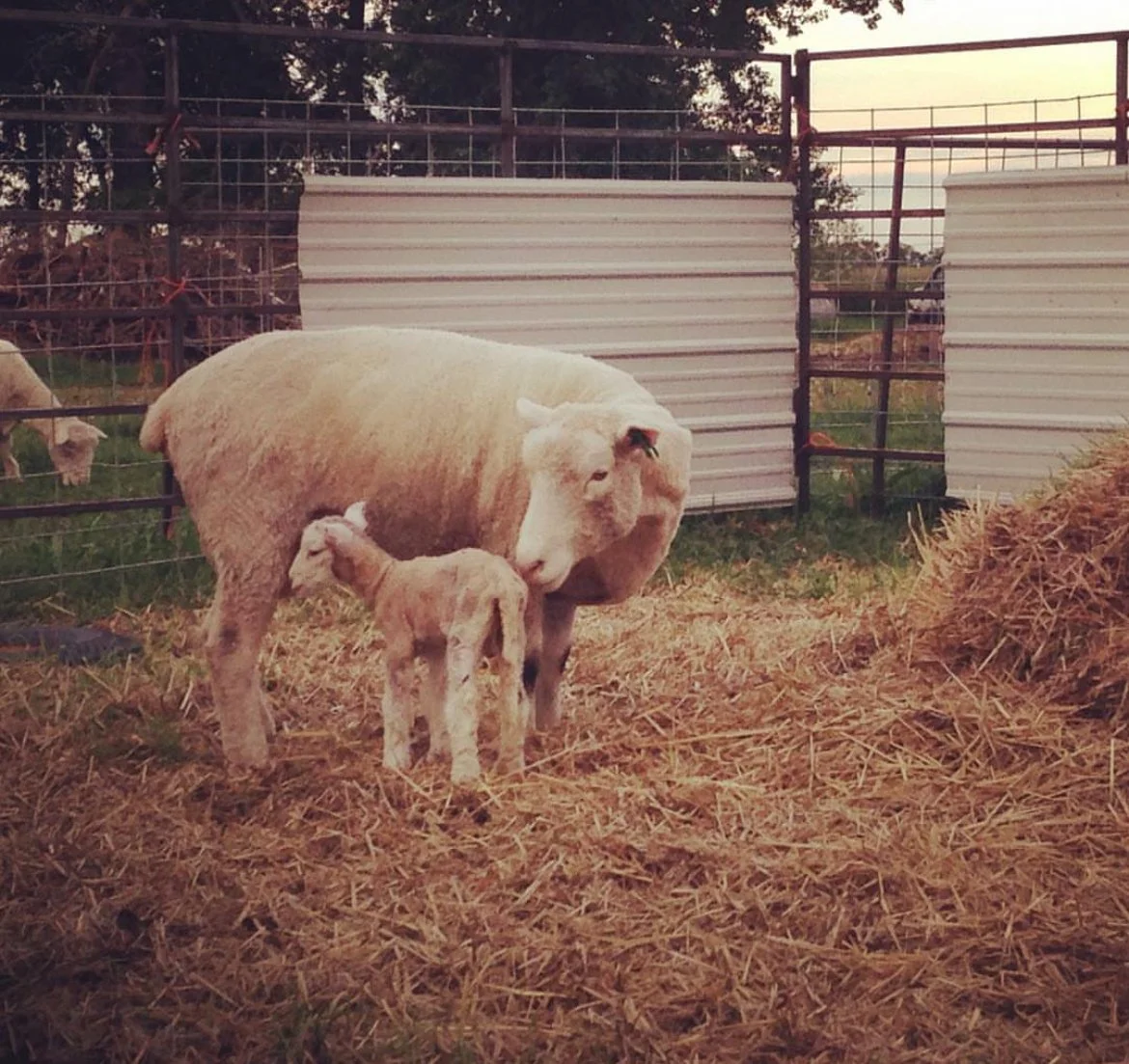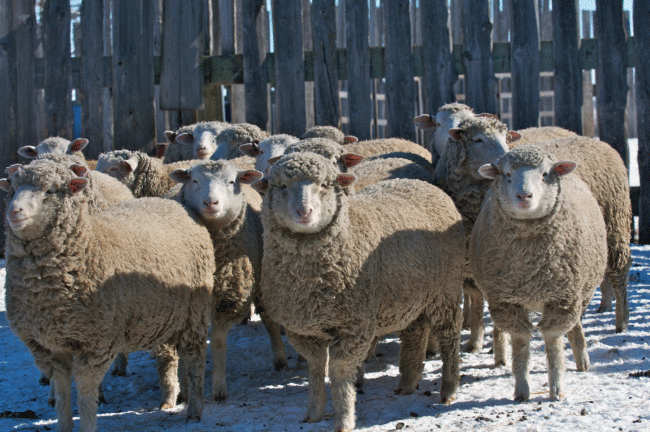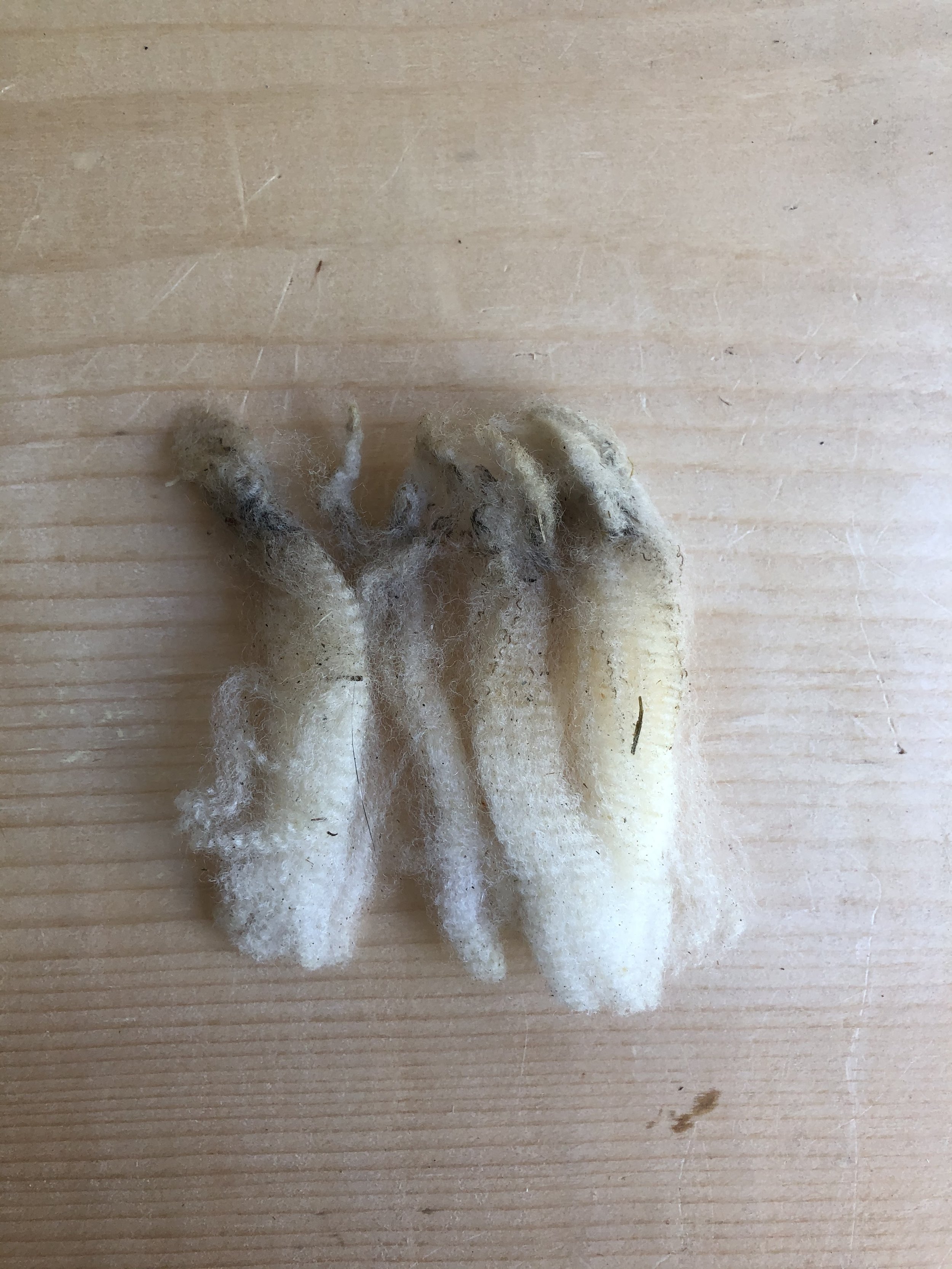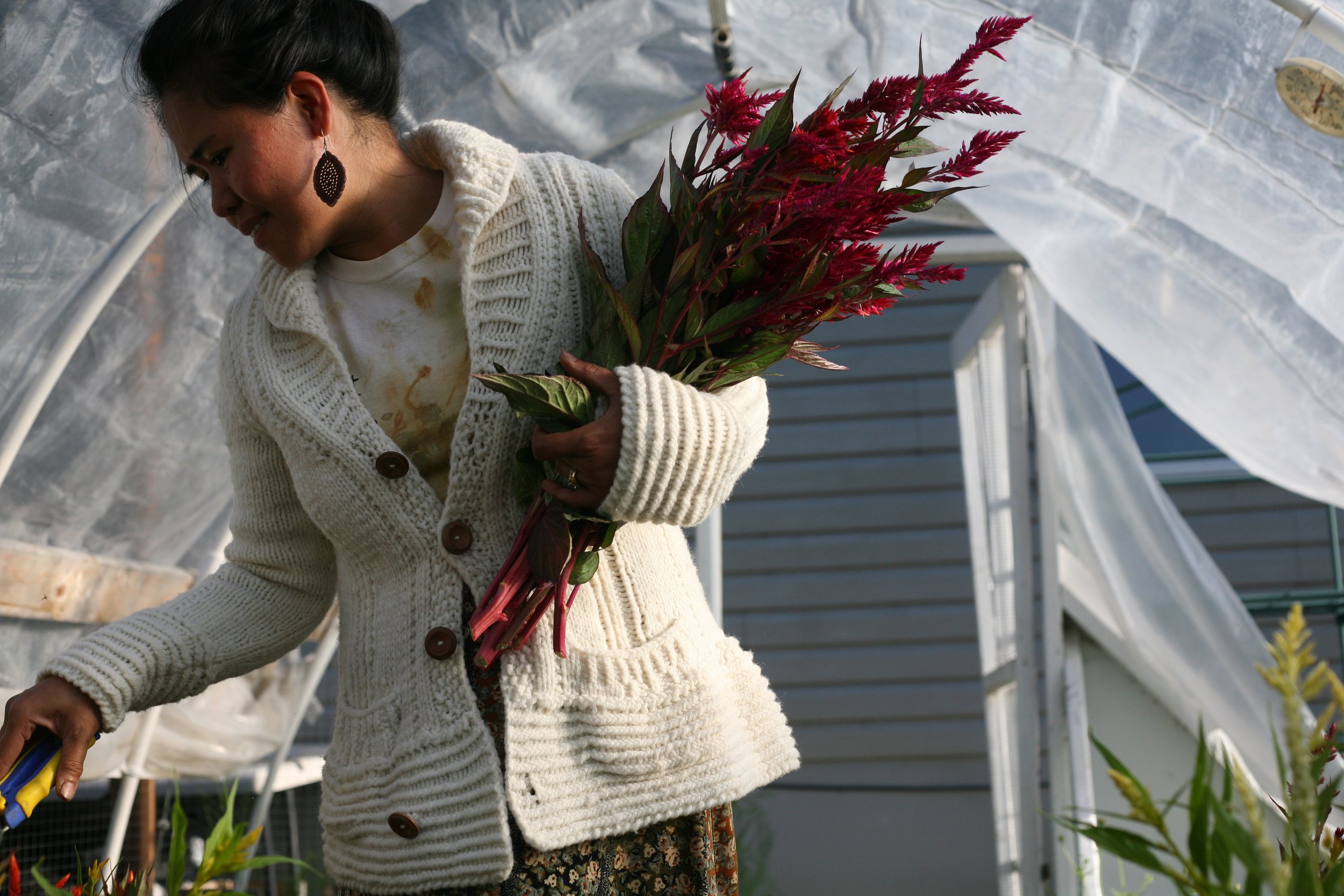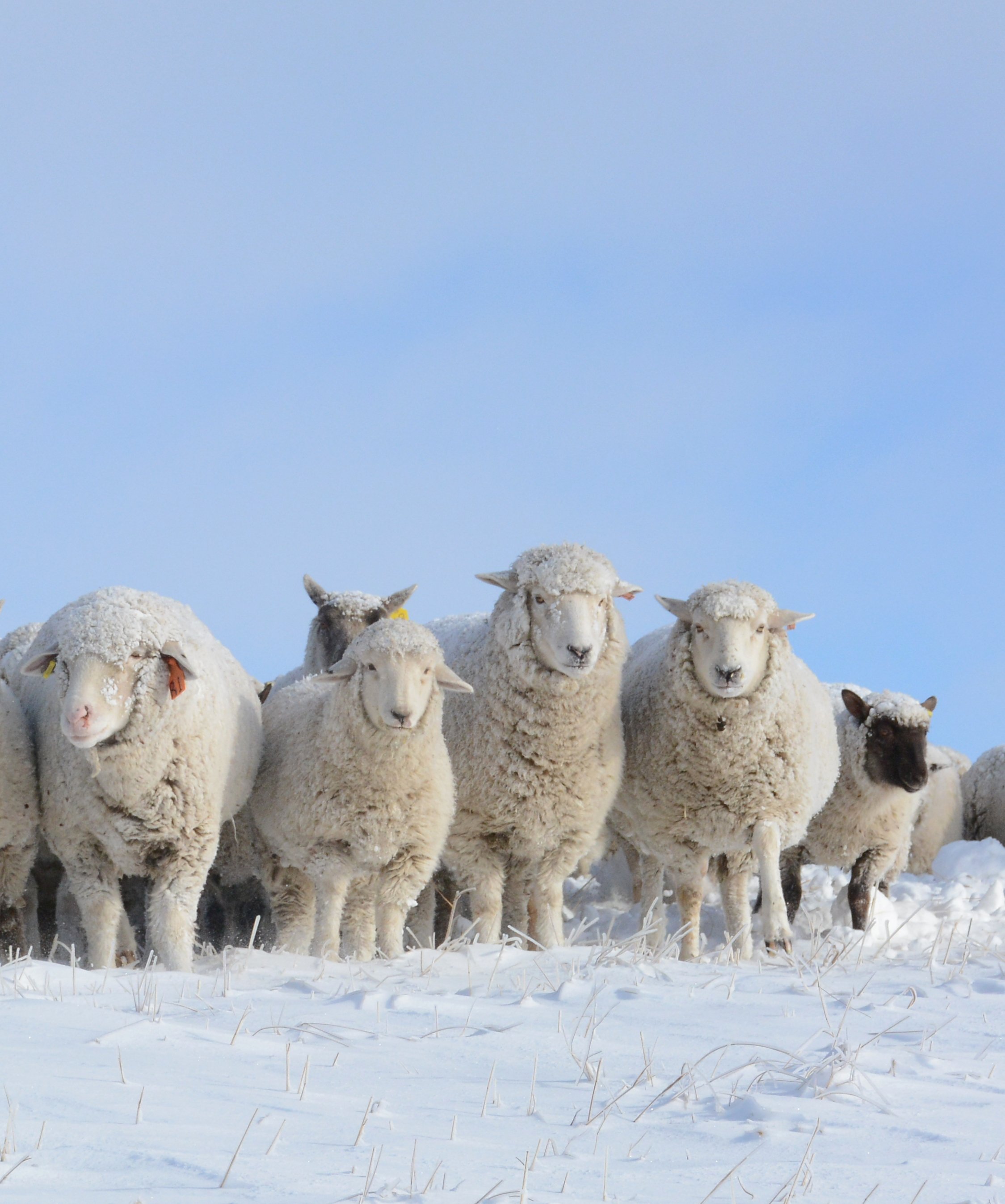Tunis
The American Tunis - or more commonly called Tunis sheep was developed from an ancient breed that dates back to biblical times, the Tunisian Barbary sheep. They came to N. America from North Africa in the late 1700's as a gift from the Bey of Tunis and was popular among American presidents.
However the civil war resulted in the destruction of most flocks and it became a conservation breed. Tunis sheep are raised predominantly for their meat, and seem to flourish in hotter climates.
When you look at Tunis wool 'on the hoof' it almost appears red (like their faces) but once washed and processed it simply has a creamy warmth to it (although some lab fleeces do appear more red or tan. It is a versatile wool and can be lofty with bounce, and some can be fine and lovely for next to the skin.
Tunis can be used for clothing items and is a great choice for showing off stitich definition and textured items. The creamy colour itself is a draw for garments. The fleece will take dye well and will felt easily.
average staple length: 3" - 6" inches
fibre diameter: 24 - 31 microns
fleece weight is 6 - 15lbs
consistent crimp, a bit blocky and fairly open. sometimes has pointed tips.
Our Tunis Wool comes from Sherry & Harold Bosma from Dusty Ridge Ranch. They farm both Canadian Arcott and Tunis sheep and have a large commercial flock.
I got to know Sherry and Harold in 2019 when I went to show Sherry how to skirt and sort fleeces. We had such a fantastic day and now I try to go to as many of their shearing as possible.
Sherry is also a fantastic tanner of sheepskins - you can check out their farm facebook here.
Anything with texture will look great in Tunis wool, or if you want a softer/warmer white sweater - I’m considering doing the newest Bracken vest from Tin Can Knits in some Tunis yarn I have.
Shetland
Shetland sheep developed on the Shetland Islands between Scotland and Norway, the exact details of how they arrived is unknown, but likely they were introduced by scandinavian settlers. Shetlands have the finest wool among the British breeds and the depth of natural colour is unparalleled in any other breed.
Shetland wool comes in eleven main colours and many fascinating markings and patterns.
The genetics of in Shetland colours and patterns is fascinating and worth a deep dive!
Shetland wool is a combination of light weight and durability. It can be used for delicate shawls to sturdy rope. It doesn’t have noticeable lustre and the well-developed crimp gives it a light, airy feel. Shetland wool is excellent in Fair Isle knitwear and tweeds.
Shetland has 11 shades within the breed from off-white, tans, browns, gray, and black. This is by far the most stunning trait of shetland wool, and often results in awe when people see the variety of colours within a single flock. White shetland takes dye well, and the other natural colours can by overdyed.Shetland fleece will felt
average staple length: 2" - 10"" inches
fibre diameter: 20 - 30 microns
fleece weight is 2-5lbs
Locks can vary
Triangular dense locks withvariable crimp
Our Shetland wool comes from our very own flock of shetland sheep! Follow us on instagram to see our everyday life with these beautiful sheep!
There are so many interesting things to use with Shetland wool - fair isle knitting is an obvious choice - but I also love the Hap Shawl a traditional shetland wool project.
Polled Dorset
Polled Dorset sheep is a breed that was developed out of the Dorset Horn sheep (polled refers to the lack of horns). The Dorset Horn breed was developed many hundreds of years ago and is currently on the Conservation Breed list. The Polled Dorset is quite popular in North American sheep farms. The North American version was developed at the North Carolina State University in 1956. Researchers developed a breeding program out of a research flock of Dorset Horn sheep that had developed a mutation that resulted in the sheep not having horns.
The Dorset (both Horn and Polled) can breed out of season and are very prolific. This makes them a great choice for sheep operations that want lambs year round for the commercial meat markets and want good mothering and multiple births. They are easy to raise and can thrive on a variety of conditions and land bases.
This is a very versatile wool! It has a lot of bounce - almost like a sponge - with dense locks. This breed only produces white wool and has more of a matte appearance. The staple is an average length and the crimp is very irregular. The micron count is representative of more of a medium wool and can be utilized in many different ways.
The wool can be processed in many different ways to produce a lovely and versatile finished product. Dorset wool can be spun for loft (more like a woolen spun) and has historically been used in the production of flannels and tweeds. It can also be spun as a worsted style yarn for a more smooth yarn and used in garments, blankets and other garments. Dorset wool will take dye well. It will not felt readily and we have often used Dorset wool in our pillows and other bedding items.
average staple length: 3 - 5 inches
fibre diameter: 26 - 33 microns
fleece weight is between 5 - 9lbs
Dense locks with strong and irregular crimp
We purchase our Polled Dorset wool from a medium sized sheep farm in south-central Manitoba (near Stonewall). They raise just over 300 Dorset and BFL sheep. They are focused on meat production and have beautiful wool as well.
I dyed up the DORSET wool in some fun colours and sets of mini skeins - so anything with colourwork would be a perfect fit for this full-bodied yarn in beautiful colours!
Ile de France
The Ile de France breed was developed in France in 1832 in response to falling wool prices. Shepherds crossed the Rambouillet/Merino's with a Dishley Leicester to improve meat production. The result was a sheep that adds hardiness, longevity and excellent flocking instincts to a flock. They also produce a beautiful high-quality wool that has retained it's merino characteristics.
The breed was first brought to Canada in 1995 to a farm in Alberta via embryo transplant. The breed moved from there into other parts of N. America where it continues to be a popular breed among medium and large sheep farms in Canada.
Ile-de-France (IDF) can be variable in terms of how we can use it (as evidence by the range of micron count) Some IDF can be fine enough that you can wear it next to your skin, while some would be better as outerwear clothing or used in felting projects. It depends on the flock that you source it from and the individual fleeces.
IDF wool has a clear defined crimp and lovely loft. The staple length however is on the shorter side and will make for some great spinning. It will felt readily and would be a good choice for any of your felting projects – the wool takes dye well with a crisp white base colour.
If you are knitting, crocheting or weaving with IDF wool it will show off stitch/weave definition well and will have some great body and bounce. I highly recommend cables with this yarn or a bouncy moss stitch!
Staple length: 2.75” -3.5”
Fibre diameter: 23 – 30 microns
Fleece weight is 6 - 13lbs
Structure: Well defined locks with slightly pointy tips
Our Ile de France wool comes from local Manitoba farm Seine River Shepherds. Randy, Solange and their son Michel raise a large flock of sheep and they produce the most beautiful felted and hand sewn jackets and vests!
Share with us your patterns made with the Ile de France yarn and Fibre!
Polypay
The Polypay breed is a dual purpose sheep and was created to produce good quality meat, but also beautiful wool. It's name actually means "many ways to provide return on investment" It is a mix of Targhee, Dorset, Rambouillet and Finnsheep genetics.
The breed was created at a USDA sheep experimentation centre in the 1970s. The sheep perform well on farm pasture or on a range and they are very prolific, they have beautiful wool and they are excellent mothers. Polypay wool most likely is prevalent in commercial yarn because of its consistent staple lengths and relative fineness.
Polypay wool is known for its equal parts softness and body. It is a full-bodied wool that will provide loft and bounce (thanks to its dorset influence) but also will be fine and wearable (thanks to the rambouillet and targhee influence)
Polypay only grows white but takes dye very well, and it will felt. It is excellent for blankets, sweaters, hats or mittens, and will also show off textured patterns well.
For handspinning keep the handling light to avoid clumping and thinning out.
Staple length: 3 - 5 inches
Fibre diameter: 22 - 29 microns
Fleece weight is 7 - 11lbs
Structure: Well developed crimp slightly tapered tips matte in appearance
Brian Greaves moved to Canada in 1993 to start Silver Bend Ranch with his wife, Karen Hill. They along with their children, Alison and Mark, raise cattle and sheep just north of Miniota, Manitoba.
Brian brought with him 18 years of New Zealand farm experience. In his last job as Livestock Manager of an 8,500 acre farm in New Zealand, he managed 16,000 ewes, 1,000 cattle, 350 breeding deer, 1000 goats and 25 brood mares.
Brian now farms 2¼ sections of light sandy soil. Formerly a grain farm, Brian has transformed it into a stock farm by developing both tame and native pastures, using multi-species grazing and rotational grazing, fencing dugouts and waterways, and using remote solar watering systems. As well, he has added corrals, pole sheds, calving barn, workshop, solar system and a new home.
After starting in 1993 with 10 heifers, 25 lease cows and 100 ewes, Silver Bend Ranch currently runs 140 cow-calf pairs and 80 ewes. Over the years, Brian has developed a commercial line of ewes with high fertility, fast lamb growth, high carcass quality and an average 10 lb. of fine range quality wool per head.
Brian is a certified wool grader, and is a trained wool judge and shearing competition judge. He is also a retired shearer who runs shearing schools for the Canadian Cooperative Wool Growers (CCWG).
Currently, Brian is the sheep and goat producer representative on the National Farm Animal Transport Code Development Committee. He also served as the MB Director of the Canadian Cooperative Wool Growers from 1999 - 2019 and was the representative on the Canadian Sheep Value Chain Roundtable.
He served as a producer representative on the National Farm Animal Sheep Code Development Committee and is a past director of the Manitoba Sheep Association and the Canadian Sheep Federation. Brian served his community on the Soil Conservation committee and as a volunteer Firefighter with the Miniota Fire Service.
Brian and Karen received the Upper Assiniboine Conservation District Award in 2009 and the Red River Ex Farm Family of the Year award in 201
I used the polypay wool in this beautiful sweater to show off the texture - more details coming soon.
BFL - Blue Faced Leicester
The Blue Faced Leicester (pronounced LESS-ters) get their name from the dark blue (appearing) skin showing through the white hair on their heads.
They were developed to play a role in the development of mules - a cross of both meat and wool sheep breeds - in the early twentieth century in the north of England. They are raised in the UK, Canada and the USA. BFL sheep are mostly white, however there can also be dark black or grey.
BFL is the finest of the longwool breeds, it has the durability and lustre of the longwools with the next-to-skin softness. BFL wool takes dye well and is moderately feltable.
BFL yarn has a range of uses - socks, sweaters and other garments. BFL garments will hold up well to intense wear, but are soft enough to be comfortable next to the skin. BFL yarn is great for weaving and items will drape well without feeling heavy.
Staple length: 3-6"
Fibre diameter: 24 - 28 microns
Fleece weight is between 2.5 - 4.5lbs
Structure: Distinctive spiraling locks
Our BFL wool is sourced from a new to us farm in Central Manitoba - we were so pleased to find a new breeder of BFL in the region. I hope to get to the farm in the next few months to take photos and see their operation!
BFL Pattern recommendations coming soon!
BFL wool - hand dyed by subscriber Mari
Icelandic
Icelandic sheep first came to iceland with the viking settlers around 930 CE, and since then it's been illegal to introduce new sheep to iceland.
The breed has been developed in isolation and is one of the purest breeds in the world. It makes up 25% of the agriculture revenue in iceland for both meat and wool. The first icelandic sheep were brought to N. America in 1985 in Ontario.
Icelandic wool is double coated, the coarse outer wool is called the 'tog' and the soft undercoat is called the 'thel' when the two are loosely spun together the yarn is called 'lopi'. The thel fibre can be fine enough for next to skin wear, but the tog can be more coarse and with lots of strength. Icelandic sheep have a variety of natural colours including white, tan, brown, gray, black and a mix of those.
Icelandic wool is very warm and will do excellent for outwear sweaters and jackets (picture the icelandic sweaters that have become so popular) they also make excellent mittens, leg warmers and other outerwear items.The white wool takes dye well and overdyeing the natural colours can produce beautiful shades.
There are many small-scale icelandic sheep farm in Manitoba, as we also have a large icelandic population. Processing Icelandic wool is more complex because of the vastly different staple lengths, it is most often spun as a single ply, but if the sheep are shorn more than once year, the fibre an be spun as a plied yarn.
Staple length: outercoat: 4 - 18" undercoat 2-4"
Fibre diameter: outercoat 27 - 31 microns, undercoat 19-22 microns
Fleece weight is between 4 - 7 lbs
Structure: triangular staple lenght (you can clearly the tog and thel in this photo)
Our Icelandic wool is sourced from local historian and Icelandic genealogist Nelson Gerrard. He raises purebred Icelandic sheep on his farm in Gimli Manitoba
Coming Soon
Border Cheviot
When you look at many of the newer breeds, specifically in commercial meat farms, you will see the genetics of the Cheviot breed.
The original cheviot breed originated in the British Islands and named after the Cheviot hills. These hills were actually formed by volcanic lava flows over 400 million years ago. The tallest point known as the cheviot is 815 meters above sea level. There were three original cheviot breeds: Border Cheviot, Brecknock Hill Cheviot and North Country Cheviot. They were first brought to North America in 1838 and are a very common sheep in Canada. The North Country Cheviot are one of the more common breeds in Atlantic Canada.
The Cheviot breeds have a distinctive physical appearance, white faced with perky ears and Roman noses. The Cheviot breed is very active and is excellent for training border collies or other herding dogs. The breed is raised predominantly for meat but the wool can be lovely in a variety of forms
Border Cheviots are not considered an original down breed, but their wool is similar in many aspects to the true down wools. The wool would be considered of medium softness, but has significant resilience and a robust body to it. The wool in general does not have the same elasticity and loft as down wool - but in many ways responds in a similar manner.
Cheviot wool is excellent for sweaters, socks and other garments that will not be worn next to the skin. It will show off textured patterns and is a great option for cabled patterns. The wool will take dye, but will give a chalky like appearance. Cheviot wool is not ideal for felting, but is an excellent wool for bedding. (We use cheviot wool for our wool pillows). The Cheviot breed only produces white fleeces.
Staple length: 4 - 5"
Fibre diameter: 27 - 33 microns
Fleece weight is between 5 - 10lbs
Structure: Rectangular staples with slightly pointed tips. The Cheviot breed all have a three dimensional crimp.
Our Cheviot wool is sourced from a local Manitoba regenerative farm owned and operated by Graham and Janice Rannie near Russel Manitoba. They have a large operation of purebred Rambouillet and purebred Cheviot sheep on pasture. You can find more info about their farm here.
We use the Border Cheviot wool in our pillow wool blend - it has so much body and bounce - and doesn’t felt easily, so it’s perfect for using in our pillows.
Please share with us your knitting or spinning projects.
East Friesian
East Friesian sheep originated in Germany in the Friesland region of Germany and the Netherlands - hence their name. They were used predominantly as a dairy breed and provided excellent milk for cheese!
A German couple by the name of Chris Buschbeck and Axel Meister immigrated to Canada in the 1980's and missed all the delicious sheep cheese and milk from their homeland and couldn't find an equivalent breed in Canada.
In 1994 they imported East Friesian embryos from Germany and began the first flock of East Friesians in N. America. They are quite popular in Quebec where the majority of dairy breeds thrive in Canada. The sheep are calm and docile (which makes milking them twice a day very convenient).
The wool from the East Friesian breed can be somewhat variable, but many would describe it as a more rustic wool with more coarseness than other fine or medium type wools. The breed is generally white, but can also be a beautiful dark brown/black and sometimes you will even find sheep that are white with spots (some have compared them to holstein cow of the sheep industry).
Spinning this wool in a worsted or semi-worsted style will produce a smooth and finer-feeling wool, where as spinning it woolen style will give a more full-bodied but more toothy feeling yarn. It will have a lot of air and loft and very insulating.
This yarn would be best suited to outerwear - jackets, vests, legwarmers and perhaps mittens or even a hat if lined with something more fine. It would make a great blanket to use while having a picnic or perhaps a winter campfire!
It will take dye well and produce more of a matte appearance due to its low lustre. The wool will felt.
Staple length: 3 – 6 inches
Fibre diameter: 28 - 33 microns
Fleece weight is between 9 - 13lbs
Structure: blocky dense locks
PICTURE COMING SOON
Audrey Boulet of Les Bresbis du Beaurivage in Quebec supplies our East Friesian wool. This is a little farther than we usually travel to get our wool - but I love what Audrey is doing and I had to try out her wool!
Audrey started her farm as a dairy sheep farm. Her first product is milk that she sells to a local buyer for cheese! It wasn’t until a few years of searching for somewhere useful for her wool to go that she partnered up with a local dyer and started producing a yarn line. Now Audrey has a beautiful line of yarn, socks, roving, blankets and sheepskins. Make sure you check out her farm store if you want more of this amazing wool.
This is our first time ever including East Friesian wool in our breed study, we look forward to your recommendations for how it spins and knits/crochets.
Targhee
Targhee sheep are named after the national forest station that housed the USDA sheep experiment, where the breed was developed. They took Rambouillet rams and bred them with Corriedale and lincoln/rambouillet ewes. The goal being to develop a hardy dual-purpose sheep that would thrive on range and farms in the west and high plains. This explains why Targhee sheep are so popular in Montana, Saskatchewan, Idaho and Alberta.
Because of the influence of it's fine wool ancestors, targhee wool is very soft with a lovely handle. Targhee wool has a lot of loft and good elasticity. It feels soft and bouncy to work with and wears well too.
Targhee wool will felt and it takes dye very well with almost a matte surface. The wool is always white. Targhee wool is excellent for 'next to skin' items, and will also be resilient to harder wearing. You can't go wrong with hats, mittens, sweaters and shawls.
Staple length: 3 – 5” inches
Fibre diameter: 22 - 25microns
Fleece weight is between 10 - 14lbs
Structure: Dense uniform matte locks with lots of crimp.
We have sourced our wool from a few different farms in Southern Saskatchewan, but recently we get it from Terry and Kathy Towle. We had it recently micron tested and it was very fine - about 18 microns!
Terry and Kathy actually raise Targhee’s for the express purpose of training their herding dogs. They have a beautiful flock and they live a few miles from my extended family, so I get to visit their farm regularly!
I am currently knitting the Cider Sweater from Tin Can Knits - it has cables that the targhee wool exposes beautifully!
Romney
Romney sheep come from the Romney Marsh – a salt march in southeast England which was made habitable by an ancient system of drainage ditches and seawalls. They grow excellent fleeces even in wet conditions. They were first imported to America in 1904 and they thrive in humid climates like the Pacific Northwest. They are a large sheep who are friendly and can also be used for meat. They have been used as well in the development of other breeds such as the Romeldale and coopworth breeds.
Romney wool can range from medium-course to fine. This means that Romney wool can be used in a variety of ways, the more coarse wool is great in carpets and sturdy outerwear, and the finer wool can be used in clothing. Romney wool can have incredible lustre and the natural shades of romney sheep is stunning from black to steel grey, silver and white, and some brown.
Romney can felt, although the feltability can depend on the fleece. The fleece will take dye well and this is a great fibre for those who like to experiment with hand spinning.
The more coarse romney fibres are excellent for household textiles, seat covers, carpets and outerwear and socks. The more fine fibres will be lovely for hats, mittens and socks.
Staple length: 4 - 8” inches
Fibre diameter: 29 - 45 microns
Fleece weight is between 8 - 12lbs
Structure: Distinct locks with uniform, bold crimp
Much of our long wool breeds come from Gerry Oliver (Spirit Sands Shepherds) in Carberry, Manitoba.
Gerry has been a fibre farming mentor to me in many ways - a fearless leader in the industry, an incredible farmer who produces amazing wool. Gerry sells raw wool from rare breeds and if you like to process wool be hand from beginning to end I highly recommend her products - you can see more here.
coming soon
Shropshire
The Shropshire breed originates from south-western England and is a cross between Southdown and the Leicester or Cotswold Ram. In 1853 it became a recognized breed and began to grow in popularity in English flocks. Raised predominantly as a meat breed because of its large size, quick growth and prolificacy it was once the most common breed in N. America.
Because most "Down" breeds are meat sheep, their wool is often disregarded and many farmers will even burn or discard it because it is simply not worth as much money as other wool. However, Down wool can be incredibly hard-wearing, extremely lofty, full of elasticity and an excellent choice for many of your knitting or crochet projects. All true Down breeds have a dark face and white fleece.
Shropshire wool has a very dense,blocky staple formation. The crimp is consistent and tight, which provides it a great amount of elasticity and loft. It has been spun with a moderate amount of twist to maintain the bounce of the fibre, and it's a 2-ply yarn to highlight the natural loft of the fibre.
Shropshire yarn can be used for many different projects and is best suited for outerwear projects and insulating layers. The elasticity allows for excellent socks or mittens, and the loft and insulation will make excellent outerwear sweaters.
Shropshire wool takes dye well, but lacks any lustre, so will produce more of a chalky colour. Our Shropshire yarn is made with wool sourced from Gerry Oliver's farm Spirit Sands Shepherds in Brandon, Mb. Geryy has a mixed flock of unique breeds and sells breeding stock and fleeces.
Staple length: 2.5 - 4” inches
Fibre diameter: 26 - 29 microns
Fleece weight is between4.5 - 10lbs
Structure: dense, blocky locks.
Details coming soon from the Manitoba Farm that we source our Jacob wool from.
Lambing Mitts
A huge thank you to Tracey Kirouac for sharing a photo and pattern recommendation for the Shropshire yarn. She has made the Lambing Mitts!
Those look so amazing, I wonder if I can make a pair in time for our lambing! Thanks for sharing Tracy
Pattern: Lambing Mitts
Designer: Veronika Jobe
Yarn: Shropshire 3-ply (Long Way Homestead)
Jacob
The Jacob sheep is a British sheep breed, but it’s true origins are not known. Some think it originated from Spain and then cross-bred with British sheep, but no one is certain. The breed gets it name from the bible, in the old testament, and a reference to Jacob taking every speckled and spotted sheep from his father-in-laws flock and breeding them. Jacob sheep were seen as ‘ornamental’ sheep and were kept not as a production sheep (for meat or wool) but as ornaments in many British parks. They are a smaller breed with some unique traits.
The first thing that is noticeable about the Jacob sheep is the multiple horns they have growing from their skull. Jacob sheep can have 2, 4 or 6 horns and they are considered Polycerates (meaning "many-horned") animal. They also are a piebald animal – meaning they have a pattern of unpigmented spots (white) on a background of pigmented (dark) fibre.
Jacob sheep are hardy and are excellent grazers in poorer conditions (although all those horns can be hard on a shepherds infrastructure) and they are very attentive mothers to their lambs. They are on the conservation watch list to ensure their genetics are preserved.
Jacob wool has a fair amount of variability within it – obviously the colour is variable – not only from one sheep to another, but even on an individual animal you can find spots of white, black, brown, lilac or gray. The different colours will vary slightly from each other in texture and staple. If you are ever able to purchase and process a Jacob fleece by hand you will have the opportunity to see this variation up close. However, we blend the fleece together and the variation doesn’t play a role in our preparation of the fibre.
Jacob wool is open and lofty and will have some lustre to it, some fleeces contain kemp fibres and the variation within the fleece can produce a more ‘tweed’ like fabric. The depth of colour within the fleece is perhaps the Jacob’s strongest asset and can be used in designs that will benefit from a rich colour or tweed like appearance.
The micron count will vary, so some fleeces may be fine enough for next to skin projects, while others would be more suited to outerwear. Jacob wool is lovely for sweaters, hats, mittens, vests and other textiles. Jacob wool can be dyed – but would you really want to – with such stunning colours to begin with?
Staple length: 3 – 6 inches
Fibre diameter: 25 – 35 microns
Fleece weight is between 4 – 5.5lbs
Structure: Slightly pointed tips, some lustre and moderate crimp.
Details coming soon from the Manitoba Farm that we source our Jacob wool from.
This is our first time ever including Jacob wool in our breed study, we look forward to your recommendations for how it spins and knits/crochets.
seriously - how cute is this jacob lamb??
Clun Forest
The Clun Forest sheep is from the welsh border area of Britain and is mostly found in the UK, Canada and the USA.
The breed was first imported to N. America in in 1959 but the breed disappeared shortly after. But then in 1970 a Nova Scotian shepherd named Tony Turned imported 40 ewes and 2 rams and reinvigorated the North American population of the breed.
They thrive in open pastures or ranges and wooded hills. They are a breed made from a mix of Shropshire and Ryland breeds. The breed is very good mothers and very prolific. The breed standard is dark faces and legs with a woolly forelock.
Clun Forest is raised for meat, but the wool is not to be overlooked. It is a very uniform wool and is considered a down wool – meaning a short staple, low luster and lots of elastic crimp. Clun Forest wool is always white and is very dense.
The wool from Clun Forest sheep will be hard wearing and also very full bodies. It is good for flannels, hard wearing mittens, tweeds or felts. It is also great for stuffing for pillows or duvets as it will maintain it's loft!
The fleece will take dye nicely, but doesn't have any lustre. It has a lot of body in it and will show texture or lace well too!
Staple length: 2.5 - 4" inches
Fibre diameter:25 - 28 microns
Fleece weight is between 4.5 - 6.5lbs
Shape: Rectangular, blocky locks with defined crimp
Loch Lomond Livestock
We source our Clun Forest wool from Brooke Aitken and her family farm in Eyebrow, SK.
They have a large flock of cattle and sheep that they run on a large range of forage and native prairie. You can learn more about the farm here.
Coopworth
The Coopworth breed was developed in New Zealand after World War 2. The goal was to develop a breed that would increase hardiness and lambing percentages while also maintaining wool quality. The breed was developed by crossing Border Leicester and Romney sheep. The Coopworth breed was brought to Canada in 1985 by Agriculture Canada. They worked with the founders of Louet (manufacturer of spinning wheels and more) to bring in 20 ewes and 5 rams and the breed grew from there. The Coopworth breed was meant to be a practical sheep and has always been evaluated in terms of breed standard due to their performance in fleece production, fertility and growth rate rather than by their parentage. The Coopworth sheep thrive on wetter lowlands and are well suited to the environment in New Zealand. The sheep are a medium to large sized breed with white legs and faces and often will have wool on the tops of their heads!
The wool from the Coopworth breed may have some variability depending on where the stock comes from. Generally the wool has a beautiful lustre and a longer staple, it has consistent relaxed crimp and pointed locks. It is not overly greasy and there shouldn’t be too much weight loss from scouring. The breed is generally white, but in some regions there may be some gray or brown Coopworth sheep.
Coopworth wool can be an enjoyable fibre to work with for many different projects. The yarn will have resilience and durability, but with a higher micron range may be best suited for outerwear projects. The crisp handle will result in great stitch definition, so try this yarn out with textured designs or cables. The wool has moderate feltability and will take dye well.
Staple length: 5 - 8" inches
Fibre diameter: 30 - 39 microns
Fleece weight is between 8 - 17lbs
Form:Staple can be round or flat with pointed tips.
This is the first time we’ve worked with the Coopworth breed. We sourced it from Woolley’s Farm in Norfolk County, Ontario. Carrie Woolley runs a large flock of 1500 ewes in a silvopasture operation.
Silvopasture is the practice of having trees or shrubs live in tandem with livestock in pastures and on grazing lands. They graze their sheep in various woodlots, and also between the rows of their fruit tree operation. In addition they solar graze their flock on large solar farms (thereby limiting the use of fossil fueled mowers for solar farms).
This is a new yarn to us - so send us your pattern recommendations!
Rambouillet
Rambouillet sheep are often referred to as the french-merino, they were established in 1786 in Roubouillet France. In 1840 they were first introduced in the USA and it quickly spread through N. America.
They are a large sheep and fairly fast growing. They adapt well to many types of forage and can survive on sparse native grasslands and they thrive in arid conditions. Rambouillets have adequate meat, but are raised primarily for high-quality wool.
There are many large Rambouillet farms in the Canadian Prairies, which they are well suited for due to their flocking instinct. They will spread out during the day to graze a wide range of land but then bunch up tightly at night to sleep.
Rambouillet is incredibly soft and has amazing handle. It is a great wool for those next to the skin projects and will feel great to work with. Some folks say that rambouillet is like Merino but with a bit more bounce. Because of it's slightly disorganized crimp it provides great elasticity and beautiful loft.
Rambouillet is a very greasy wool, and the tips are often the most dirty. It requires very hot water for washing and much of the weight of the fibre will be lost during washing.
Most Rambouillet is white, however, some farmers are experimenting by introducing coloured rams into he flock genetics to get coloured rambouillet fleeces.
Rambouillet does not have the same lustre as merino, but it will take dye well with almost a matte appearance. Rambouillet will felt very easily and is great for needle or wet felting projects. Rambouillet is a great choice for your baby items, and next to the skin projects!
Staple length: 2 - 4" inches
Fibre diameter:18 - 24 microns
Fleece weight is between 8 - 18lbs
Shape: Square, dense flat-tipped staples with slightly disorganized crimp
Rambouillet Farm
Our Rambouillet wool is sourced from a local Manitoba regenerative farm owned and operated by Graham and Janet Rannie near Russel Manitoba. They have a large operation of purebred Rambouillet and purebred Cheviot sheep on pasture. Graham is experimenting breeding his Rambouillet ewes with a coloured Merino ram to get a fine brown/black wool. You can find more info about their farm here.
Pattern Recomondations
We love rambouillet in any format, we have done 2 or 3 ply and our favourite is a thick single ply yarn. Check out these beautiful patterns knit in our Rambouillet breed of the month using 1 skein.
Hats!
Chunky Cabled Headband by Michelle Greenberg (Knit by Leanne @theknittystew)
Here is what Leanne has to say about the headband she knit “Rambouillet is so lofty and next to skin soft. The single ply and thick/thin nature of this particular skein makes it ideal for texture (specifically cables).”
Cabled Hat
Hat Pattern by (Knit by Carmen @carmen_acanadiangirl)
“The bulky Rambouillet was so squishy and delectable, I couldn't resist! It was also a lovely knit, although I made it a little too small for my head. I still wear it all the time though! I will say this wool had so much variation in thickness that it was a little different to work with but it still ended up being wonderful. “
Corriedale
About the Sheep
The Corriedale breed was developed in New Zealand in the 1880's as a dual purpose breed intended to graze on pastures that were not well suited to the dominant sheep breeds already being used. Originally developed by breeding Merino sheep and the Lincoln long-wool sheep. The intention (and result) was a hardy animal who thrived on a range of conditions and provide both excellent meat and wool. They are a prominent breed in South America and can also be found in Canada, Australia, New Zealand, South Africa and the USA. They are often recognizable by the wooly 'topknots' on the top of their heads.
To learn more about Corriedales check out the the Australian Corriedale Association
About the Wool
Corriedale wool is a versatile, reliable fibre and can be utilized in many ways. Although there can be large variances within the breed (and even sometimes on an individual animal) it is generally a medium-fine wool with a long staple, some luster and a well defined, tight crimp.
The crimp means there is lots of resilience and loft, and the fineness of corriedale means it can also be worn next to the skin. Corriedale wool and yarn can be found commercially with relative ease and can also be found as a local farm yarn across Canada and the USA. Corriedales are usually white, but also come in gray through black and beige to brown.
Corriedale felts remarkably well and is excellent for taking dye. It is a great fibre for socks (with its long staple and resiliency and the fineness. It also works for sweaters, mittens, blankets, clothing and household textiles.
Average staple length: 3 - 6" inches
Fibre diameter: 25 - 31 microns
Fleece weight is between 10 - 20lbs
Form: Rectangular and dense locks with clearly defined crimp
Our wool is sourced from a large range farm in Southeastern Saskatchewan. The farmers focus on raising quality herding dogs, and the sheep are a happy by-product. They run a flock of approximately 500 ewes that are pasture raised on the vast range of Saskatchewan.
We generally spin this Corriedale wool as a lofty 2-ply to show off the bouncy nature of the wool.
Thanks to Gabrielle Ayres for these beautiful pictures of her Knotwork Cabled Headband made with our 3-ply corriedale yarn from this years Breed of the Month.
Mittens
Past participants have enjoyed making mittens with corriedale (both the 3-ply version) and the 2-ply version like these thrummed mittesn pictured. Patterns we recommend that will use 1 skein only:
Thrummed Mittens - Tanis Fibre Arts
Worlds Simplest Mittens - Tin Can Knits
Windrow Mittens - Meghan Huber
Socks
Bonnie made these socks out of her handspun corriedale wool. She got the motif from Pinterest and developed the pattern from a standard ladies sock pattern
Canadian Arcott
The Canadian Arcott breed is the second in our special 'made in Canada' breed study. Like the Rideau Arcott the breed was developed by the Agricultural Research Centre of Ottawa (ARCOTT) between the 1960's and 1980's. The Canadian Arcott was created using the Suffolk, Ile-de-France, Leicester, North Country Cheviot and Romnelet genetics. The breed is generally used as a meat breed in Canada, and are often described as being short and thick. They can adapt to either pasture based operations or confinement farming operations. The breed is almost always white, but they often have mottled coloured faces.
The Development of Canadian Arcott Sheep
If you want to read more about the development of the various Arcott breeds, check out this document from Agriculture Canada
The wool from the Canadian Arcott can be variable. Within a flock the wool can be quite different, and defining the breed standard can be a bit challenging. In general, Canadian Arcott wool is considered a medium wool, and can be enjoyable to work with both as a spinner or a knitter/crocheter.
The wool has beautiful lustre and will produce beautiful results if dyed. Canadian Arcott wool is white, although their faces have some mottling/colour.
Canadian Arcott wool will be a great choice for clothing like sweater, mittens, hats and even blankets. It has a rounded, full bodied feel to it, and will work great for textured pieces or cables.
Staple length: 2.5 - 3.5" inches
Fibre diameter: 24 - 24 microns
Fleece weight is between 4.5 - 5.5lbs
Form:Rectangular, blocky locks with defined crimp
We source our Canadian Arcott wool from Sherry & Harold Bosma from Dusty Ridge Ranch. They farm both Canadian Arcott and Tunis sheep and have a large commercial flock.
I got to know Sherry and Harold in 2019 when I went to show Sherry how to skirt and sort fleeces. We had such a fantastic day and now I try to go to as many of their shearing as possible.
Sherry is also a fantastic tanner of sheepskins - you can check out their farm facebook here.
I had the pleasure of joining Harold and Sherry for an Agriculture in the Classroom video tour of their farm and Q&A of our mill. You can check it out here:
Leg Warmers - In the Weeds Pattern by Melissa Labarre (to make these with one skein make them a one lace repeat shorter on each leg warmer)
Rideau Arcott
The Rideau Arcott breed is the first in our special 'made in Canada' breed study.
The Rideau Arcott is a truly 'Canadian' breed. The government of Canada developed 3 breeds of sheep in the 70's and 80's: Canadian Arcott, Rideau Arcott and Outaouais Arcott. Arcott stands for Agricultural Research Centre of Ottawa. The Rideau was developed using Finnsheep, Suffolk, Shropshire, Dorset and East Friesian sheep and was designed mostly for meat, but their wool has found it's own niche. In Manitoba there are many farms still raising Canadian and Rideau Arcott sheep.
The Development of Canadian Arcott Sheep
If you want to read more about the development of the various Arcott breeds, check out this document from Agriculture Canada
Rideau wool is considered a 'variable' wool, some can be fine, long and lustrous, while other can be more lofty and down. Rideau can be white, grey, brown and even black.
The wearability of Rideau wool often depends on the specific animal or flock it comes from, some can be worn next to the skin as shawls or hats, and some is better suited for outerwear like sweaters or mittens. The wool can have a brilliant lustre and takes dye well. It is a great wool for felting
Staple length: 2.5" - 4" inches
Fibre diameter: 25 - 35 microns
Fleece weight is between 5 - 7lbs
Form: tight, consistent crimp, tight lock formation, some lustre
We source our Canadian Arcott wool from a few different places, but the majority comes from Sandy Ridge Sheep - Ingrid and Remco are the farmers and they run a commercial meat flock raising Rideau Arcott and Romonav sheep. Ingrid is passionate about the wool and lamb industry and I’ve appreciated her pragramtism towards building both side of the industry together!
I really fell in love with the breed through my neighbour and ‘farm wife’ as I call her Christel Lanthier of Ferme Fiola Farm. She has done an incredible job of focusing on the wool of her Rideau sheep and has some absolutely beautiful colour and quality. You can check her out here. (Christel is also the creative genius behind all the photos for my book Sheep, Shepherd & Land - you can pick up a copy here)
Thanks to steph for this photo and the pattern recommendation. She spun this yarn from the Breed of the Month roving, then dyed the yarn and knit the socks.
Steph said she chain plied the yarn to make the socks!
Find the pattern here.
This beautiful hat was designed by a local Manitoban designer! And used one skein of naturally dyed Rideau wool from Ferme Fiola Farm. (this is one of my favourite patterns)
Another Manitoba Designer - Ash Alberg designed this beautiful shawl with Ridea from Ferme Fiola Farm - if you can get your hands on more skeins of Ridea, this is a beautiful project
